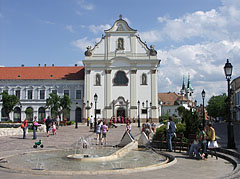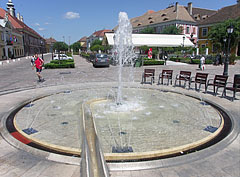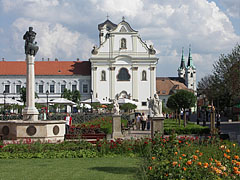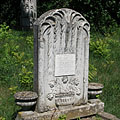
 Туристическа информация
Туристическа информация
(Оптимизирана за устройства с малък екран)
Downtown, main square - Vác, Унгария
Когато кликнете върху:
Кликнете върху снимките!
-

Church of the Whites (in Hungarian "Fehérek temploma"), also known as Upper Town Parish Church, it is the former Dominican Church
дата на заснемане: 13.07.20092009
Създадено от: Роберт Немет
Модел на фотоапарата: Konica Minolta Dimage A200
Vác, Унгария
-

Municipal House (Tow Hall) of Vác
дата на заснемане: 13.07.20092009
Създадено от: Роберт Немет
Модел на фотоапарата: Konica Minolta Dimage A200
Vác, Унгария
-

The renovated main square of Vác with charming fountain and the baroque building of the Dominican Church ("Church of the Whites", Fehérek temploma)
дата на заснемане: 24.05.20082008
Създадено от: Роберт Немет
Модел на фотоапарата: Konica Minolta Dimage A200
Vác, Унгария
-

Fountain in the main square
дата на заснемане: 13.07.20092009
Създадено от: Роберт Немет
Модел на фотоапарата: Konica Minolta Dimage A200
Vác, Унгария
-

Vác, Унгария
-

Park decorated with roses in the main square with the former Dominican Church ("Church of the Whites", Fehérek temploma), and in the distance the double steeples of the Piarist Church
дата на заснемане: 24.05.20082008
Създадено от: Роберт Немет
Модел на фотоапарата: Konica Minolta Dimage A200
Vác, Унгария
-

Wedding is very common in the magnificent sceneries of the Church of the Whites (Fehérek temploma)
дата на заснемане: 24.05.20082008
Създадено от: Роберт Немет
Модел на фотоапарата: Konica Minolta Dimage A200
Vác, Унгария
-

Church of the Whites (Fehérek temploma) or the former Dominican Church, the ornate rococo style interior
дата на заснемане: 24.05.20082008
Създадено от: Роберт Немет
Модел на фотоапарата: Konica Minolta Dimage A200
Vác, Унгария
-

A lot of onlookers
дата на заснемане: 24.05.20082008
Създадено от: Роберт Немет
Модел на фотоапарата: Konica Minolta Dimage A200
Vác, Унгария
-

The glass covered exhibition in the center of the ruin garden
дата на заснемане: 24.05.20082008
Създадено от: Роберт Немет
Модел на фотоапарата: Konica Minolta Dimage A200
Vác, Унгария
-
Church of the Whites (Fehérek temploma) with the ruin garden in the main square
дата на заснемане: 24.05.20082008
Създадено от: Роберт Немет
Модел на фотоапарата: Konica Minolta Dimage A200
Vác, Унгария
Church of the Whites (Fehérek temploma) with the ruin garden in the main square - Vác, Унгария -
Statue of Saint Hedwig (Jadwiga of Poland) in the side of the Church of the Whites (Fehérek temploma)
дата на заснемане: 24.05.20082008
Създадено от: Роберт Немет
Модел на фотоапарата: Konica Minolta Dimage A200
Vác, Унгария
Statue of Saint Hedwig (Jadwiga of Poland) in the side of the Church of the Whites (Fehérek temploma) - Vác, Унгария -
Statue of Saint Hedwig (Jadwiga of Poland) in the side of the Church of the Whites (Fehérek temploma), with a babbling fountain
дата на заснемане: 24.05.20082008
Създадено от: Роберт Немет
Модел на фотоапарата: Konica Minolta Dimage A200
Vác, Унгария
Statue of Saint Hedwig (Jadwiga of Poland) in the side of the Church of the Whites (Fehérek temploma), with a babbling fountain - Vác, Унгария -
дата на заснемане: 24.05.20082008
Създадено от: Роберт Немет
Модел на фотоапарата: Konica Minolta Dimage A200
Vác, Унгария
- Vác, Унгария -
дата на заснемане: 24.05.20082008
Създадено от: Роберт Немет
Модел на фотоапарата: Konica Minolta Dimage A200
Vác, Унгария
- Vác, Унгария -
дата на заснемане: 24.05.20082008
Създадено от: Роберт Немет
Модел на фотоапарата: Konica Minolta Dimage A200
Vác, Унгария
- Vác, Унгария -
Main square, baroque statue near the Town Hall and the Provost Major's Palace (in Hungarian "Nagypréposti palota") in the background
дата на заснемане: 13.07.20092009
Създадено от: Роберт Немет
Модел на фотоапарата: Konica Minolta Dimage A200
Vác, Унгария
Main square, baroque statue near the Town Hall and the Provost Major's Palace (in Hungarian "Nagypréposti palota") in the background - Vác, Унгария -
Main square, baroque statue at the Town Hall
дата на заснемане: 13.07.20092009
Създадено от: Роберт Немет
Модел на фотоапарата: Konica Minolta Dimage A200
Vác, Унгария
Main square, baroque statue at the Town Hall - Vác, Унгария -
Baroque facade of the Town Hall
дата на заснемане: 13.07.20092009
Създадено от: Роберт Немет
Модел на фотоапарата: Konica Minolta Dimage A200
Vác, Унгария
Baroque facade of the Town Hall - Vác, Унгария -
Fountain in the main square, and farther in the shadow it is the Church of the Whites with the sculpture of Saint Dominic of Osma
дата на заснемане: 13.07.20092009
Създадено от: Роберт Немет
Модел на фотоапарата: Konica Minolta Dimage A200
Vác, Унгария
Fountain in the main square, and farther in the shadow it is the Church of the Whites with the sculpture of Saint Dominic of Osma - Vác, Унгария -
Sentimental picture in the main square of Vác
дата на заснемане: 13.07.20092009
Създадено от: Роберт Немет
Модел на фотоапарата: Konica Minolta Dimage A200
Vác, Унгария
Sentimental picture in the main square of Vác - Vác, Унгария -
The colorful houses of the main square
дата на заснемане: 13.07.20092009
Създадено от: Роберт Немет
Модел на фотоапарата: Konica Minolta Dimage A200
Vác, Унгария
The colorful houses of the main square - Vác, Унгария -
Baroque statue on a column in front of the former Dominican Church (the "Church of the Whites")
дата на заснемане: 13.07.20092009
Създадено от: Роберт Немет
Модел на фотоапарата: Konica Minolta Dimage A200
Vác, Унгария
Baroque statue on a column in front of the former Dominican Church (the "Church of the Whites") - Vác, Унгария -
Statue of Saint Hedwig (Jadwiga of Poland) near the Church of the Whites (Fehérek temploma)
дата на заснемане: 13.07.20092009
Създадено от: Роберт Немет
Модел на фотоапарата: Konica Minolta Dimage A200
Vác, Унгария
Statue of Saint Hedwig (Jadwiga of Poland) near the Church of the Whites (Fehérek temploma) - Vác, Унгария -
дата на заснемане: 13.07.20092009
Създадено от: Роберт Немет
Модел на фотоапарата: Konica Minolta Dimage A200
Vác, Унгария
- Vác, Унгария -
дата на заснемане: 13.07.20092009
Създадено от: Роберт Немет
Модел на фотоапарата: Konica Minolta Dimage A200
Vác, Унгария
- Vác, Унгария -
дата на заснемане: 09.03.20142014
Създадено от: Роберт Немет
Модел на фотоапарата: Konica Minolta Dimage A200
Vác, Унгария
- Vác, Унгария -
дата на заснемане: 09.03.20142014
Създадено от: Роберт Немет
Модел на фотоапарата: Konica Minolta Dimage A200
Vác, Унгария
- Vác, Унгария -
дата на заснемане: 09.03.20142014
Създадено от: Роберт Немет
Модел на фотоапарата: Konica Minolta Dimage A200
Vác, Унгария
- Vác, Унгария -
дата на заснемане: 09.03.20142014
Създадено от: Роберт Немет
Модел на фотоапарата: Konica Minolta Dimage A200
Vác, Унгария
- Vác, Унгария -
дата на заснемане: 09.03.20142014
Създадено от: Роберт Немет
Модел на фотоапарата: Konica Minolta Dimage A200
Vác, Унгария
- Vác, Унгария -
дата на заснемане: 09.03.20142014
Създадено от: Роберт Немет
Модел на фотоапарата: Konica Minolta Dimage A200
Vác, Унгария
- Vác, Унгария -
дата на заснемане: 09.03.20142014
Създадено от: Роберт Немет
Модел на фотоапарата: Konica Minolta Dimage A200
Vác, Унгария
- Vác, Унгария -
дата на заснемане: 09.03.20142014
Създадено от: Роберт Немет
Модел на фотоапарата: Konica Minolta Dimage A200
Vác, Унгария
- Vác, Унгария -
дата на заснемане: 09.03.20142014
Създадено от: Роберт Немет
Модел на фотоапарата: Konica Minolta Dimage A200
Vác, Унгария
- Vác, Унгария -
дата на заснемане: 09.03.20142014
Създадено от: Роберт Немет
Модел на фотоапарата: Konica Minolta Dimage A200
Vác, Унгария
- Vác, Унгария -
дата на заснемане: 09.03.20142014
Създадено от: Роберт Немет
Модел на фотоапарата: Konica Minolta Dimage A200
Vác, Унгария
- Vác, Унгария -
дата на заснемане: 09.03.20142014
Създадено от: Роберт Немет
Модел на фотоапарата: Konica Minolta Dimage A200
Vác, Унгария
- Vác, Унгария -
дата на заснемане: 09.03.20142014
Създадено от: Роберт Немет
Модел на фотоапарата: Konica Minolta Dimage A200
Vác, Унгария
- Vác, Унгария -
дата на заснемане: 09.03.20142014
Създадено от: Роберт Немет
Модел на фотоапарата: Konica Minolta Dimage A200
Vác, Унгария
- Vác, Унгария -
дата на заснемане: 09.03.20142014
Създадено от: Роберт Немет
Модел на фотоапарата: Konica Minolta Dimage A200
Vác, Унгария
- Vác, Унгария -
дата на заснемане: 09.03.20142014
Създадено от: Роберт Немет
Модел на фотоапарата: Konica Minolta Dimage A200
Vác, Унгария
- Vác, Унгария -
дата на заснемане: 09.03.20142014
Създадено от: Роберт Немет
Модел на фотоапарата: Konica Minolta Dimage A200
Vác, Унгария
- Vác, Унгария -
дата на заснемане: 09.03.20142014
Създадено от: Роберт Немет
Модел на фотоапарата: Konica Minolta Dimage A200
Vác, Унгария
- Vác, Унгария -
дата на заснемане: 09.03.20142014
Създадено от: Роберт Немет
Модел на фотоапарата: Konica Minolta Dimage A200
Vác, Унгария
- Vác, Унгария -
дата на заснемане: 09.03.20142014
Създадено от: Роберт Немет
Модел на фотоапарата: Konica Minolta Dimage A200
Vác, Унгария
- Vác, Унгария -
дата на заснемане: 09.03.20142014
Създадено от: Роберт Немет
Модел на фотоапарата: Konica Minolta Dimage A200
Vác, Унгария
- Vác, Унгария -
дата на заснемане: 09.03.20142014
Създадено от: Роберт Немет
Модел на фотоапарата: Konica Minolta Dimage A200
Vác, Унгария
- Vác, Унгария -
дата на заснемане: 09.03.20142014
Създадено от: Роберт Немет
Модел на фотоапарата: Konica Minolta Dimage A200
Vác, Унгария
- Vác, Унгария -
дата на заснемане: 09.03.20142014
Създадено от: Роберт Немет
Модел на фотоапарата: Konica Minolta Dimage A200
Vác, Унгария
- Vác, Унгария -
дата на заснемане: 09.03.20142014
Създадено от: Роберт Немет
Модел на фотоапарата: Konica Minolta Dimage A200
Vác, Унгария
- Vác, Унгария -
дата на заснемане: 09.03.20142014
Създадено от: Роберт Немет
Модел на фотоапарата: Konica Minolta Dimage A200
Vác, Унгария
- Vác, Унгария -
дата на заснемане: 09.03.20142014
Създадено от: Роберт Немет
Модел на фотоапарата: Konica Minolta Dimage A200
Vác, Унгария
- Vác, Унгария -
дата на заснемане: 09.03.20142014
Създадено от: Роберт Немет
Модел на фотоапарата: Konica Minolta Dimage A200
Vác, Унгария
- Vác, Унгария -
дата на заснемане: 09.03.20142014
Създадено от: Роберт Немет
Модел на фотоапарата: Konica Minolta Dimage A200
Vác, Унгария
- Vác, Унгария -
дата на заснемане: 09.03.20142014
Създадено от: Роберт Немет
Модел на фотоапарата: Konica Minolta Dimage A200
Vác, Унгария
- Vác, Унгария -
дата на заснемане: 09.03.20142014
Създадено от: Роберт Немет
Модел на фотоапарата: Konica Minolta Dimage A200
Vác, Унгария
- Vác, Унгария -
дата на заснемане: 09.03.20142014
Създадено от: Роберт Немет
Модел на фотоапарата: Konica Minolta Dimage A200
Vác, Унгария
- Vác, Унгария -
дата на заснемане: 09.03.20142014
Създадено от: Роберт Немет
Модел на фотоапарата: Konica Minolta Dimage A200
Vác, Унгария
- Vác, Унгария -
дата на заснемане: 09.03.20142014
Създадено от: Роберт Немет
Модел на фотоапарата: Konica Minolta Dimage A200
Vác, Унгария
- Vác, Унгария -
дата на заснемане: 09.03.20142014
Създадено от: Роберт Немет
Модел на фотоапарата: Konica Minolta Dimage A200
Vác, Унгария
- Vác, Унгария -
дата на заснемане: 09.03.20142014
Създадено от: Роберт Немет
Модел на фотоапарата: Konica Minolta Dimage A200
Vác, Унгария
- Vác, Унгария -
дата на заснемане: 09.03.20142014
Създадено от: Роберт Немет
Модел на фотоапарата: Konica Minolta Dimage A200
Vác, Унгария
- Vác, Унгария -
дата на заснемане: 09.03.20142014
Създадено от: Роберт Немет
Модел на фотоапарата: Konica Minolta Dimage A200
Vác, Унгария
- Vác, Унгария -
дата на заснемане: 09.03.20142014
Създадено от: Роберт Немет
Модел на фотоапарата: Konica Minolta Dimage A200
Vác, Унгария
- Vác, Унгария -
дата на заснемане: 09.03.20142014
Създадено от: Роберт Немет
Модел на фотоапарата: Konica Minolta Dimage A200
Vác, Унгария
- Vác, Унгария
Кликнете върху снимките!
Особености, характеристики
Местоположение:
GPS координати: Ширина 47°46'41", Дължина 19°7'39" (N47 46.68 - E19 7.65)
Информация, къси разкази, интересни факти
 Park decorated with roses in the main square with the former Dominican Church ("Church of the Whites", Fehérek temploma), and in the distance the double steeples of the Piarist Church
Park decorated with roses in the main square with the former Dominican Church ("Church of the Whites", Fehérek temploma), and in the distance the double steeples of the Piarist Church
The "Március 15. tér" ("March 15 Square") in Vác is one of the most beautiful baroque town square in Hungary today. The square received its current form in 2006 by the plans of Frigyes Pogány and Miklós Horler, but its typical triangular shape was developed by German settlers who arrived here after the Mongol Invasion in the 13th century.
 Wedding is very common in the magnificent sceneries of the Church of the Whites (Fehérek temploma)
Wedding is very common in the magnificent sceneries of the Church of the Whites (Fehérek temploma)
This church in Vác initially belonged to the Dominican religious order, the construction was begun in 1699 but it was completed only in 1755, led by Márton Kalcher. The rococo style interior of the church was created around 1770. The altarpiece on the columned high altar represents Pope Pius V who is begging for the success of the battle against the Turks.
The building received its "Church of the Whites" (or the "Whites' Church", in Hungarian "Fehérek temploma") name after the white religious habit of the Dominican monks that they wear under their black cloak (aka "cappa"). Surprisingly while the Dominicans were called for example in Hungary as the "White Monks", in England and other countries they are called "Black Friars" due to their black cloak. By the way, the name "White Monks" usually refers to the Cistercian friars, but sometimes it is used in relation with other religious orders as well.
It is worth to mention the statues on the facade of the church, on the two sides of the lyre-shaped window there are statues of St. Dominic and St. Emeric, as well as above it a statue of the Immaculate Conception (of Virgin Mary) can be seen. Interestingly the steeple (tower) of the Whites' Church is not on that side which has the main entrance and faces the main square, but placed on the other side of the building.
 Church of the Whites (Fehérek temploma) with the ruin garden in the main square
Church of the Whites (Fehérek temploma) with the ruin garden in the main square
The ruin garden in the middle of the town square of Vác contains the wall remains of the medieval St. Michael's Church (in Hungarian "Szent Mihály-templom") and the cemetery garden. The part that is covered with the modern glass roof is a 18th-century crypt (undercroft or "lower church"), inside it today there is an exhibition of the history of the former religious building. The St. Michael's Church stood on this place until 1761, for approximately five hundred years. The building played a dominant role in forming the surrounding cityscape, at a time there were attempts to extend it and convert into a cathedral, but it was unsuccessful. In the Turkish era Calvinists occupied the ruined church for themselves, but in 1761 it was finally demolished.
 Statue of Saint Hedwig (Jadwiga of Poland) in the side of the Church of the Whites (Fehérek temploma)
Statue of Saint Hedwig (Jadwiga of Poland) in the side of the Church of the Whites (Fehérek temploma)
Queen Jadwiga of Poland was born in 1373 as the daughter of King Louis I of Hungary and Elizabeth of Bosnia. Just like St. Elizabeth of Hungary she was the patron of the poor people and the orphans. She distributed her assets among the poors and set up a foundation for the University of Kraków (aka Kraków Academy, today Jagiellonian University or in Polish "Uniwersytet Jagielloński"). She died in Kraków, Poland in 1399 at a young age (she was only 26), during the birth of her first child.
 Statue of Saint Hedwig (Jadwiga of Poland) in the side of the Church of the Whites (Fehérek temploma), with a babbling fountain
Statue of Saint Hedwig (Jadwiga of Poland) in the side of the Church of the Whites (Fehérek temploma), with a babbling fountain
The body of St. Hedwig (in Polish Jadwiga) was buried in Kraków, Poland, below the altar of the Wawel Cathedral. Not in the royal crypt because everybody was sure she will be canonized soon. But this happened only in 1997, thanks to Pope John Paul II (born as Karol Józef Wojtyła) the first Polish Bishop of Rome. Independently from this she was venerated as a saint already after her death, and she was always represented according to this.
Since 2006 St. Hedwig is the patron saint of the Danube Bend (in Hungarian "Dunakanyar"), the region where Vác is located. The statue in Vác beside the Church of the Whites ("Fehérek temploma") was created by Tibor Horváth and László Sáros in 2006, in the year when the town square was renovated.
 Main square, baroque statue near the Town Hall and the Provost Major's Palace (in Hungarian "Nagypréposti palota") in the background
Main square, baroque statue near the Town Hall and the Provost Major's Palace (in Hungarian "Nagypréposti palota") in the background
The Provost's Palace (in Hungaran "Nagypréposti palota") was built in the mid-18th century, it is the residence of the great provost (or high provost, provost major). The provost is a high-rank senior official in many Christian Churches, he is the head of the chapter and the adviser of the bishop. The renovated building is the home of the Diocesan Collection of Vác.
 Municipal House (Tow Hall) of Vác
Municipal House (Tow Hall) of Vác
The Town Hall is considered the most significant baroque secular building of Vác. According to a map from 1680 formerly there was a Turkish bath building on its site, but a source from 1718 already shows a town hall here. The present-day building was built from 1730 until the visit of Empress Maria Theresa in 1764.
The central figure on the facade of the building is the statue of Justitia (or Iustitia, Lady Justice), the goddess of justice. There are two other female figures on both sides with coat of arms, one is of Hungary and the other one is of Bishop Kristóf Migazzi who financed the construction.
 Church of the Whites (in Hungarian "Fehérek temploma"), also known as Upper Town Parish Church, it is the former Dominican Church
Church of the Whites (in Hungarian "Fehérek temploma"), also known as Upper Town Parish Church, it is the former Dominican Church
During the renovations of the church of the 1990s, more precisely in 1994 the workers found a forgotten entrance, a way down behind a bricked-up door. This way led to a vaulted crypt where there were a lot of (total of 265) 170 to 270-year-old highly decorated coffins stacked almost to the ceiling. Instead of skeletons there were naturally formed mummies in the coffins, dressed in funeral clothes.
With the permission of the Bishopric of Vác scientific studies have been performed on the "Mummies of Vác" and the site as well. Today the funerary objects are kept in the Tragor Ignác Museum that conducted the exploration, and the bodies (except a baby mummy) are within the Anthropological Collection of the Hungarian Natural History Museum ("Magyar Természettudományi Múzeum"). The finds give an insight into the everyday life, habits and beliefs of the people of different origins, ages and social backgrounds, who lived here about 200 years ago. Moreover, even their facial features can be discovered thanks to the scientists.
A sensational discovery related to the finds that some of the found mummified people were probably fully resistant against more deadly diseases when they lived. The cause of it is still under investigation, but the resistance was probably due to genetic mutations. In the near future this research could be a great help to the medical science.
Vác - Повече фото галерии:
Можете също така да се интересуват от (Свързани страници):
Дестинации в пътеводителя:
Vác (232 снимки + 2 панорамни изображения)
Danube Bend (Dunakanyar) (1 769 снимки + 6 панорамни изображения)
Пещ медйе (15 122 снимки + 50 панорамни изображения)
Будапеща и околностите (15 989 снимки + 52 панорамни изображения)
Унгария (27 287 снимки + 163 панорамни изображения)
и в допълнение:
(в рамките тук: Пещ медйе и Danube Bend)
Pilis Mountains (Pilis hegység) (335 снимки)
Buda Hills (Budai-hegység) (8 632 снимки + 21 панорамни изображения)
Gödöllő Hills (Gödöllői-dombság) (4 203 снимки + 21 панорамни изображения)
Visegrád Mountains (Visegrádi-hegység) (116 снимки + 1 панорамни изображения)
Cegléd (125 снимки + 2 панорамни изображения)
Ráckeve (92 снимки)
Dunakeszi (259 снимки)
Göd (23 снимки)
Nagykőrös (250 снимки + 2 панорамни изображения)
Nagymaros (31 снимки)
Pilisvörösvár (88 снимки)
Szentendre (597 снимки + 1 панорамни изображения)
Visegrád (220 снимки + 1 панорамни изображения)
Esztergom (110 снимки + 1 панорамни изображения)
Dunakeszi (259 снимки)
Göd (23 снимки)
Nagymaros (31 снимки)
Szentendre (597 снимки + 1 панорамни изображения)
Visegrád (220 снимки + 1 панорамни изображения)
Csővár (105 снимки)
Kóspallag (53 снимки)
Márianosztra (37 снимки)
Nagybörzsöny (4 снимки)
Pilisszentkereszt (122 снимки)
Nógrád (181 снимки)
Zsámbék
Всеки панорамна снимка тук:
Vác (2 снимки)
Danube Bend (Dunakanyar) (6 снимки)
Пещ медйе (50 снимки)
Будапеща и околностите (52 снимки)
Унгария (163 снимки)
Европа (165 снимки)
Всяка нормална снимка тук:
Vác (232 снимки / 4 галерии)
Danube Bend (Dunakanyar) (1 769 снимки / 31 галерии)
Пещ медйе (15 122 снимки / 221 галерии)
Будапеща и околностите (15 989 снимки / 234 галерии)
Унгария (27 287 снимки / 462 галерии)
Европа (30 494 снимки / 523 галерии)
https://www.panadea.com/bg/guidebook/vac/photos/gal-001

Добави към Любими Добави към Отметките
Споделете с вашите приятелите!
и т.н.
Всички права запазени
- ©2010-2022
Neuronit Creative Studio - Mogyoród / Будапеща / Унгария



